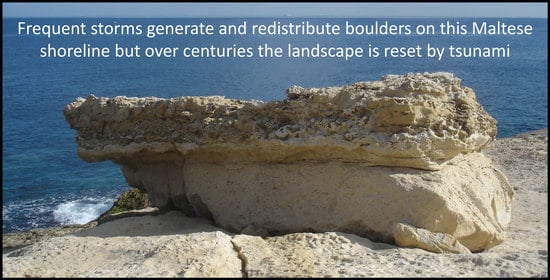Reconstructing Boulder Deposition Histories: Extreme Wave Signatures on a Complex Rocky Shoreline of Malta
Abstract
:1. Introduction
2. Study Site and Context
2.1. Geographical and Geological Setting
2.2. Geomorphology of the Coastal Slope
3. Materials and Methods
3.1. Field Observations and Time-Sequential Imagery
3.2. Boulder Transport Modelling
3.3. Wave Velocity Decay Model
4. Results
4.1. Boulders of Interest: Morphometric Considerations
4.2. Boulders of Interest: Field Observations and Time-Sequential Imagery
4.2.1. Boulders Emplaced by Storms 1957–2013 (Recent Movers, RM)
4.2.2. Boulders Interpreted as Potentially Tsunamigenic in Origin (Ancient Movers, AM)
4.2.3. Boulders of Indeterminate History (Indeterminate Movers, IM)
4.3. Boulders of Interest: Hydrodynamic Considerations
5. Discussion
6. Conclusions
- The study adopted a mixed methods approach for detecting and contrasting boulder histories, bringing together evidence from field survey, analysis of time-sequential imagery and hydrodynamic modelling. Each method proved valuable in generating unique insights but in complement they have enabled a degree of confidence in revealing the impacts of both contemporary storm waves and ancient extreme waves on the complex shore landscape at Żonqor.
- Tracking of boulder movements between 1957 and 2013 focused on the role of contemporary storm waves and enabled an irrefutable group of recent movers to be identified and their transport pathways to be reconstructed and compared. Out of six intervals between successive images, four reveal notable movements. Surprisingly, storm waves are rearranging boulders along the Żonqor coast at frequent intervals and with varying magnitude, with some storms merely performing tinkering work while others are quite capable of pivoting and lifting megaclasts over the Globigerina scarp, thus freeing them from their lower shoreline trap and initiating their subsequent and intermittent shunting up the platform ramp.
- The field survey provided corroborating evidence which added detail to recent mover pathways and enabled speculation of the nature of often complex movements but, inevitably, attention was drawn to the more ancient boulders, classified as such by a range of diagnostic criteria. This led to establishing the notable boulder berm as the boundary separating the shoreward contemporary platform surface, impacted by regular storm waves, from the landward ancient surface with numerous boulders exhibiting significant weathering. Close inspection of a number of the ancient movers suggests that they must have remained static for centuries in order to develop their delicate weathering features. A unique finding for this site is the landward-facing (reverse) imbrication of individuals in the boulder fields at c. 10–12 m asl. The implication is that a wave (or waves) of sufficient magnitude must have travelled further inland to higher elevations in order to create powerful enough backwash necessary to create the reverse imbrication attitudes. Therefore, there is strong evidence that the majority of the ancient movers inspected have been positioned on the landscape by either historical extreme storm waves, of greater magnitude than recent events, or they are tsunamigenic in origin.
- The hydrodynamic modelling results are offered as auxiliary evidence, acknowledging the large uncertainty associated with estimating velocities required for boulder transport/emplacement and whether waves are of sufficient power to generate them. Despite this caution, the results provide the wave run-up context both to define the realm of the recent movers and also to suggest a limited range of storm wave activity, leaving many of the ancient movers clearly immovable by events of comparable magnitude to those of the last half century or so. In addition, the modelling exercise explored the likely velocities required to overturn two ancient movers, closer to the shoreline, with somewhat inconclusive results for one of the boulders suggesting that its pivot over the Globigerina scarp theoretically could have been performed by a storm wave; the other of sufficient elevation to cautiously suggest a tsunami-driven movement.
- The result is a complex assemblage of boulders at Żonqor, with clearly defined groupings, attributable in different ways to both contemporary storm waves and ancient extreme events—a palimpsest where regular storms of varying magnitude appear to rework the distribution of boulders close to the shoreline at surprisingly frequent intervals but over long time periods the landscape becomes reset by tsunami. In light of this, a fully informed understanding of the nature and implications of impacts of such events on coastal environments needs to be developed by agencies in Malta responsible for coastal safety and management.
- Finally, the study provided a test-bed for performing a novel revised method for defining the velocity decay profile associated with wave run-up, which can be compared with existing boulder transport models for ascertaining those boulders likely to have been moved under different design wave conditions. The theoretical formulation is provided together with equations for practical application. The method requires calibration against a known boulder movement and overcomes some of the criticisms associated with converting wave velocity to wave height in the Nott approach, thus providing an alternative means of discriminating between the impact of extreme waves of both storm and tsunami origin.
Supplementary Materials
Author Contributions
Funding
Acknowledgments
Conflicts of Interest
Appendix A
Appendix A.1. Wave Velocity Decay Model
Appendix A.1.1. Theoretical Derivation
Appendix A.1.2. Equations for Practical Application
Appendix B
Appendix B.1. Characteristics of Boulders of Interest
| Group | Variable | Median | Maximum | Minimum | Range |
|---|---|---|---|---|---|
| Recent Movers (RM) | a-axis (m) | 3.8 | 8.5 | 1.5 | 7.0 |
| Box volume (m3) | 6.99 | 55.25 | 1.80 | 53.45 | |
| Box mass (1000 kg) | 13.29 | 104.98 | 3.42 | 101.56 | |
| Elevation (m asl) | 3.54 | 5.88 | 2.60 | 3.28 | |
| Distance to shoreline (m) | 22.0 | 31.0 | 10.0 | 21.0 | |
| Indeterminate Movers (IM) | a-axis (m) | 3.6 | 6.7 | 2.0 | 4.7 |
| Box volume (m3) | 8.30 | 62.31 | 1.65 | 60.66 | |
| Box mass (1000 kg) | 15.77 | 118.39 | 3.14 | 115.25 | |
| Elevation (m asl) | 6.10 | 7.74 | 2.34 | 5.40 | |
| Distance to shoreline (m) | 39 | 55 | 11 | 44 | |
| Ancient Movers (AM) | a-axis (m) | 1.6 | 6.2 | 1.0 | 5.2 |
| Box volume (m3) | 0.58 | 31.25 | 0.25 | 31.00 | |
| Box mass (1000 kg) | 1.09 | 59.37 | 0.48 | 58.89 | |
| Elevation (m asl) | 10.06 | 11.97 | 4.70 | 7.27 | |
| Distance to shoreline (m) | 65 | 92 | 11 | 81 |
Appendix C
Appendix C.1. Kruskal–Wallis Test between Boulder Groups
| Variable | H-Factor | p-Value | |
|---|---|---|---|
| Boulder Characteristics | a-axis (m) | 39.30 | <0.01 |
| Box volume (m3) 1 | 15.30 | <0.01 | |
| Contextual Factors | Elevation (m asl) | 28.37 | <0.01 |
| Distance to shoreline (m) | 27.51 | <0.01 |
References
- Mastronuzzi, G.; Sansò, P. Large boulder accumulations by extreme waves along the Adriatic coast of southern Apulia (Italy). Quat. Int. 2004, 120, 173–184. [Google Scholar] [CrossRef]
- Mastronuzzi, G.; Pignatelli, C.; Sansò, P.; Selleri, G. Boulder accumulations produced by the 20th of February, 1743 tsunami along the coast of south-eastern Salento (Apulia region, Italy). Mar. Geol. 2007, 242, 191–205. [Google Scholar] [CrossRef]
- Scicchitano, G.; Monaco, C.; Tortorici, L. Large boulder deposits by tsunami waves along the Ionian coast of south-eastern Sicily (Italy). Mar. Geol. 2007, 238, 75–91. [Google Scholar] [CrossRef]
- Etienne, S.; Paris, R. Boulder accumulations related to storms on the south coast of the Reykjanes Peninsula (Iceland). Geomorphology 2010, 114, 55–70. [Google Scholar] [CrossRef]
- Shah-Hosseini, M.; Morhange, C.; Beni, A.N.; Marriner, N.; Lahijani, H.; Hamzeh, M.; Sabatier, F. Coastal boulders as evidence for high-energy waves on the Iranian coast of Makran. Mar. Geol. 2011, 290, 17–28. [Google Scholar] [CrossRef]
- Engel, M.; May, S.M. Bonaire’s boulder fields revisited: Evidence for Holocene tsunami impact on the Leeward Antilles. Quat. Sci. Rev. 2012, 54, 126–141. [Google Scholar] [CrossRef]
- Mottershead, D.; Bray, M.; Soar, P.; Farres, P.J. Extreme wave events in the central Mediterranean: Geomorphic evidence of tsunami on the Maltese islands. Z. Geomorphol. 2014, 58, 385–411. [Google Scholar] [CrossRef] [Green Version]
- Biolchi, S.; Furlani, S.; Antonioli, F.; Baldassini, N.; Causon Deguara, J.; Devoto, S.; Di Stefano, A.; Evans, J.; Gambin, T.; Gauci, R.; et al. Boulder accumulations related to extreme wave events on the eastern coast of Malta. Nat. Hazards Earth Syst. Sci. 2016, 16, 719–756. [Google Scholar] [CrossRef] [Green Version]
- Cox, R.; O’Boyle, L.; Cytrynbaum, J. Imbricated coastal boulder deposits are formed by storm waves, and can preserve a long-term storminess record. Sci. Rep. 2019, 9, 10784. [Google Scholar] [CrossRef]
- Roig-Munar, F.X.; Rodríguez-Perea, A.; Vilaplana, J.M.; Martín-Prieto, J.A.; Gelabert, B. Tsunami boulders in Majorca Island (Balearic Islands, Spain). Geomorphology 2019, 334, 76–90. [Google Scholar] [CrossRef]
- Mastronuzzi, G.; Capolongo, D.; Ferilli, S.; Marsico, A.; Milella, M.; Pignatelli, C.; Piscitelli, A.; Sansò, P. Tsunami maximum flooding assessment in GIS environment. In Tsunami: From Fundamentals to Damage Mitigation; Mambretti, S., Ed.; WIT Press: Southampton, UK, 2013; pp. 61–80. ISBN 978-18-4564-770-4. [Google Scholar] [CrossRef]
- Mueller, C.; Micallef, A.; Spatola, D.; Wang, X. The tsunami inundation hazard of the Maltese Islands (central Mediterranean Sea): A submarine landslide and earthquake tsunami scenario study. Pure Appl. Geophys. 2020, 177, 1617–1638. [Google Scholar] [CrossRef]
- Cox, R.; Ardhuin, F.; Dias, F.; Autret, R.; Beisiegel, N.; Earlie, C.S.; Herterich, J.G.; Kenedy, A.; Paris, R.; Raby, A.; et al. Systematic review shows that work done by storm waves can be misinterpreted as tsunami-related because commonly used hydrodynamic equations are flawed. Front. Mar. Sci. 2020, 7. [Google Scholar] [CrossRef]
- Marriner, N.; Kaniewski, D.; Morhange, C.; Flaux, C.; Giaime, M.; Vacchi, M.; Goff, J. Tsunamis in the geological record: Making waves with a cautionary tale from the Mediterranean. Sci. Adv. 2017, 3, e1700485. [Google Scholar] [CrossRef] [PubMed] [Green Version]
- Vött, A.; Bruins, H.J.; Gawehn, M.; Goodman-Tchernov, B.N.; de Martini, P.M.; Kelletat, D.; Mastronuzzi, G.; Reicherter, K.; Röbke, B.R.; Scheffers, A.; et al. Publicity waves based on manipulated geoscientific data suggesting climatic trigger for majority of tsunami findings in the Mediterranean—Response to ‘Tsunamis in the geological record: Making waves with a cautionary tale from the Mediterranean’ by Marriner et al. (2017). Z. Geomorphol. Suppl. Issue 2019, 62, 7–45. [Google Scholar] [CrossRef]
- Nott, J. Extremely high-energy wave deposits inside the Great Barrier Reef, Australia: Determining the cause—Tsunami or tropical cyclone. Mar. Geol. 1997, 141, 193–207. [Google Scholar] [CrossRef]
- Nott, J. Tsunami or storm waves?: Determining the origin of a spectacular field of wave emplaced boulders using numerical storm surge and wave models and hydrodynamic transport equations. J. Coast. Res. 2003, 19, 348–356. [Google Scholar]
- Nott, J. Waves, coastal boulder deposits and the importance of the pre-transport setting. Earth Plan. Sci. Lett. 2003, 210, 269–276. [Google Scholar] [CrossRef]
- Nandasena, N.A.K.; Paris, R.; Tanaka, N. Reassessment of hydrodynamic equations: Minimum flow velocity to initiate boulder transport by high energy events (storms, tsunamis). Mar. Geol. 2011, 281, 70–84. [Google Scholar] [CrossRef]
- Boulton, S.; Whitworth, M. Block and boulder accumulations on the southern coast of Crete (Greece): Evidence for the 365 CE tsunami in the Eastern Mediterranean. Geol. Soc. Lond. Spec. Publ. 2017, 456, 105–125. [Google Scholar] [CrossRef] [Green Version]
- Causon Deguara, J.; Gauci, R. Evidence of extreme wave events from boulder deposits on the south-east coast of Malta (Central Mediterranean). Nat. Hazards 2017, 86, 543–568. [Google Scholar] [CrossRef]
- Nandasena, N.A.K.; Tanaka, N.; Sasaki, Y.; Osada, M. Boulder transport by the 2011 Great East Japan tsunami: Comprehensive field observations and whither model predictions? Mar. Geol. 2013, 346, 292–309. [Google Scholar] [CrossRef]
- Barbano, M.S.; Pirrotta, C.; Gerardi, F. Large boulders along the south-eastern Ionian coast of Sicily: Storm or tsunami deposits? Mar. Geol. 2010, 275, 140–154. [Google Scholar] [CrossRef]
- Barbano, M.S.; Gerardi, F.; Pirrotta, C. Differentiation between boulders deposited by tsunamis and storm waves along the south-eastern Ionian coast of Sicily (Italy). Boll. Geofis. Teor. Appl. 2011, 52, 707–728. [Google Scholar] [CrossRef]
- Mottershead, D.N.; Bray, M.J.; Soar, P.J. Tsunami landfalls in the Maltese archipelago: Reconciling the historical record with geomorphological evidence. Geol. Soc. Lond. Spec. Publ. 2018, 456, 127–141. [Google Scholar] [CrossRef] [Green Version]
- Mottershead, D.N.; Bray, M.J.; Soar, P.J.; Farres, P.J. Erosional signatures characteristic of tsunami on rocky coasts of the Maltese islands. Earth Surf. Process. Landf. 2015, 40, 2093–2111. [Google Scholar] [CrossRef] [Green Version]
- Drago, A. Sea level variability and the ‘Milghuba’ seiche oscillations in the northern coast of Malta, Central Mediterranean. Phys. Chem. Earth 2009, 34, 948–970. [Google Scholar] [CrossRef]
- Komar, P.D. Beach Processes and Sedimentation, 2nd ed.; Prentice-Hall Inc.: Upper Saddle River, NJ, USA, 1998; ISBN 978-0-13-754938-2. [Google Scholar]
- Gatt, P.A. Model of limestone weathering and damage in masonry: Sedimentological and geotechnical controls in the Globigerina Limestone Formation (Miocene) of Malta. Xjenza 2006, 11, 30–39. [Google Scholar]
- Cassar, J. The use of limestone in a historic context—The experience of Malta. Geol. Soc. Lond. Spec. Publ. 2010, 331, 13–25. [Google Scholar] [CrossRef]
- Diana, G.; Cassar, J.; Zammit, G. Physical characteristics of Globigerina Limestone using ultrasonic and thermographic methods. Q. J. Eng. Geol. Hydrogeol. 2014, 47, 251–257. [Google Scholar] [CrossRef]
- Carbone, S.; Grasso, M.; Lentini, F.; Pedley, H.M. The distribution and palaeoenvironment of Early Miocene phosphorites of southeast Sicily and their relationships with the Maltese phosphorites. Palaeogeogr. Palaeoclimatol. Palaeoecol. 1987, 58, 35–53. [Google Scholar] [CrossRef]
- Baldassini, N.; Di Stefano, A. New insights on the Oligo-Miocene succession bearing phosphatic layers of the Maltese Archipelago. Ital. J. Geosci. 2015, 134, 355–366. [Google Scholar] [CrossRef]
- Pedley, H.M. The Oligo-Miocene Sediments of the Maltese Islands. Ph.D. Thesis, University of Hull, Hull, UK, 1974. [Google Scholar]
- Pedley, H.M. A palaeoecological study of the Upper Coralline Limestone, Terebratula-Aphelesia Bed (Miocene, Malta) based on bryozoan growth-form studies and brachiopod distributions. Palaeogeogr. Palaeoclimatol. Palaeoecol. 1976, 20, 209–234. [Google Scholar] [CrossRef]
- Slabe, T.; Liu, H. Significant subsoil rock forms. In Karst Rock Features: Karren Sculpturing; Carsologica 9; Gines, A., Knez, M., Slabe, T., Dreybrodt, W., Eds.; Založba ZRC: Postojna-Ljubljana, Slovenia, 2009; pp. 123–137. ISBN 978-961-254-161-3. [Google Scholar]
- Szeni, A. Subsoil shaping. In Karst Rock Features: Karren Sculpturing; Carsologica 9; Gines, A., Knez, M., Slabe, T., Dreybrodt, W., Eds.; Založba ZRC: Postojna-Ljubljana, Slovenia, 2009; pp. 103–121. ISBN 978-961-254-161-3. [Google Scholar]
- Farres, P. Palaeosoils: Legacies of past landscapes, with a series of contrasting examples from Malta. In Landscapes and Landforms of the Maltese Islands; Gauci, R., Schembri, J.A., Eds.; Springer Nature: Cham, Switzerland, 2019; pp. 141–152. ISBN 978-30-3015-456-1. [Google Scholar]
- Hansom, J.D.; Barltrop, N.P.D.; Hall, A.M. Modelling the processes of cliff-top erosion and deposition under extreme storm waves. Mar. Geol. 2008, 253, 36–50. [Google Scholar] [CrossRef]
- Barltrop, N.D.P.; Adams, A.J. The Dynamics of Fixed Marine Structures, 3rd ed.; Butterworth-Heineman: Oxford, UK, 1991; ISBN 978-1-4831-3013-2. [Google Scholar]
- Matsutomi, H.; Sakakiyama, T.; Nugroho, S.; Matsuyama, M. Aspects of inundated flow due to the 2004 Indian Ocean tsunami. Coast. Eng. J. 2006, 48, 167–195. [Google Scholar] [CrossRef]
- Tang, H.; Weiss, R. A model for tsunami flow inversion from deposits (TSUFLIND). Mar. Geol. 2015, 370, 55–62. [Google Scholar] [CrossRef] [Green Version]
- Montoya, L.; Lynett, P.; Kie Thio, H.; Li, W. Spatial statistics of tsunami overland flow properties. J. Waterw. Port Coast. Ocean Eng. 2017, 143, 04016017. [Google Scholar] [CrossRef] [Green Version]
- Holland, K.T.; Holman, R.A.; Sallenger, A.H. Estimation of overwash bore velocities using video techniques. In Coastal Sediments’ 91, Proceedings of a Specialty Conference on Quantitative Approaches to Coastal Sediment Processes, Seattle, WA, USA, 25–27 June 1991; Kraus, N.C., Gingrich, K.C., Kriebel, D.L., Eds.; American Society of Civil Engineers: New York, NY, USA, 1991; Volume 1, pp. 489–497. [Google Scholar]
- Matias, A.; Masselink, G.; Castelle, B.; Blenkinsopp, C.E.; Kroon, A. Measurements of morphodynamic and hydrodynamic overwash processes in a large-scale wave flume. Coast. Eng. 2016, 113, 33–46. [Google Scholar] [CrossRef] [Green Version]
- Cox, J.C.; Machemehl, J. Overload bore propagation due to an overtopping wave. J. Waterw. Port Coast. Ocean Eng. 1986, 112, 161–163. [Google Scholar] [CrossRef]
- Noormets, R.; Crook, K.A.W.; Felton, E.A. Sedimentology of rocky shorelines: 3: Hydrodynamics of megaclast emplacement and transport on a shore platform, Oahu, Hawaii. Sediment. Geol. 2004, 172, 41–65. [Google Scholar] [CrossRef]
- de Martini, P.M.; Barbano, M.S.; Smedile, A.; Gerardi, F.; Pantosti, D.; Del Carlo, P.; Pirrotta, C. A unique 4000 year-long geological record of multiple tsunami inundations in the Augusta Bay (eastern Sicily, Italy). Mar. Geol. 2010, 276, 42–57. [Google Scholar] [CrossRef] [Green Version]
- Dewey, J.F.; Ryan, P.D. Storm, rogue wave, or tsunami origin for megaclast deposits in western Ireland and North Island, New Zealand? Proc. Natl. Acad. Sci. USA 2017, 114, E10639–E10647. [Google Scholar] [CrossRef] [PubMed] [Green Version]
- Scheffers, A.M.; Kinis, S. Stable imbrication and delicate/unstable settings in coastal boulder deposits: Indicators for tsunami dislocation? Quat. Int. 2014, 332, 73–84. [Google Scholar] [CrossRef]
- Paris, R.; Ramalho, R.S.; Madeira, J.; Ávila, S.; May, S.M.; Rixhon, G.; Engel, M.; Brückner, H.; Herzog, M.; Schukraft, G.; et al. Mega-tsunami conglomerates and flank collapses of ocean island volcanoes. Mar. Geol. 2018, 395, 168–187. [Google Scholar] [CrossRef] [Green Version]
- Camilleri, D.H. Tsunami and wind-driven wave forces in the Mediterranean Sea. Proc. Inst. Civ. Eng. Mar. Eng. 2012, 165, 65–79. [Google Scholar] [CrossRef]
- Camilleri, D.H. Tsunami construction risks in the Mediterranean-outlining Malta’s scenario. Disaster Prev. Manag. 2006, 15, 146–162. [Google Scholar] [CrossRef]
- Tinti, S.; Armigliato, A.; Pagnoni, G.; Zaniboni, F. Scenarios of giant tsunamis of tectonic origin in the Mediterranean. ISET J. Earthq. Technol. 2005, 42, 171–188. [Google Scholar]
- Tinti, S.; Armigliato, A.; Bortolucci, E. Contribution of tsunami data analysis to constrain the seismic source: The case of the 1693 eastern Sicily earthquake. J. Seism. 2001, 5, 41–61. [Google Scholar] [CrossRef]
- Imamura, F.; Goto, K.; Ohkubo, S. A numerical model for the transport of a boulder by tsunami. J. Geophys. Res. Ocean. 2008, 113, C01008. [Google Scholar] [CrossRef]
- Mottershead, D.; Bray, M.; Causon Deguara, J. Tsunamigenic landscapes in the Maltese Islands: The Comino Channel coasts. In Landscapes and Landforms of the Maltese Islands; Gauci, R., Schembri, J.A., Eds.; Springer Nature: Cham, Switzerland, 2019; pp. 273–288. ISBN 978-3-03-015456-1. [Google Scholar]
- Bujan, N.; Cox, R. Maximal heights of nearshore storm waves and resultant onshore flow velocities. Front. Mar. Sci. 2020, 7, 309. [Google Scholar] [CrossRef]
- Mottershead, D.N. Spatial variations in intensity of alveolar weathering of a dated sandstone structure in a coastal environment, Weston super Mare, UK. In Rock Weathering and Landform Evolution; Robinson, D.A., Williams, R.B.G., Eds.; Wiley International: Chichester, UK, 1994; pp. 151–174. ISBN 978-0-471-95119-3. [Google Scholar]
- Mottershead, D.N. Coastal Weathering. In Treatise on Geomorphology, Vol 4: Weathering and Soils Geomorphology; Shroder, J.F., Pope, G.A., Eds.; Academic Press: San Diego, CA, USA, 2013; Volume 4, pp. 228–244. ISBN 978-01-2374-739-6. [Google Scholar] [CrossRef]
- Mottershead, D.N.; Gorbushina, A.; Lucas, G.; Wright, J.S. The influence of aspect, marine salts and microbes in the weathering of sandstone in two historic structures. Build. Environ. 2003, 38, 1193–1204. [Google Scholar] [CrossRef]
- Buhagiar, K.; University of Malta, Msida, Malta. Personal communication, 2020.
- de Soldanis, G.P.F.A. Il Gozo Antico-Moderno e Sacro-Profano (Gozo, Ancient & Modern, Religious & Profane); Rabat, G., Ed.; National Library of Malta: Valletta, Malta, 1746; Libr.145. Unpublished work, 1746. (In Italian) [Google Scholar]
- Ammianus, M. Res Gestae. Book XXVI.X.; Rome, Italy, c. 380 CE, pp. 16–19. Available online: http://www.tertullian.org/fathers/ammianus_26_book26.htm (accessed on 23 September 2020).
- Köng, E.; Zaragosi, S.; Schneider, J.-L.; Garlan, T.; Bachèlery, P.; San Pedro, L.; Seibert, C.; Racine, C. Untangling the complex origin of turbidite activity on the Calabrian Arc (Ionian Sea) over the last 60 ka. Mar. Geol. 2016, 373, 11–25. [Google Scholar] [CrossRef]
- Polonia, A.; Vaiani, S.C.; de Lange, G.J. Did the A.D. 365 Crete earthquake/tsunami trigger synchronous giant turbidity currents in the Mediterranean Sea? Geology 2016, 44, 19–22. [Google Scholar] [CrossRef]
- Paris, R.; Naylor, L.A.; Stephenson, W.J. Boulders as a signature of storms on rock coasts. Mar. Geol. 2011, 107, 76–90. [Google Scholar] [CrossRef]
- Cox, R.; Jahn, K.L.; Watkins, O.G.; Cox, P. Extraordinary boulder transport by storm waves (west of Ireland, winter 2013–2014), and criteria for analysing coastal boulder deposits. Earth Sci. Rev. 2018, 177, 623–636. [Google Scholar] [CrossRef]
- Cox, R.; Zentner, D.B.; Kirchner, B.J.; Cook, M.S. Boulder ridges on the Aran Islands (Ireland): Recent movements caused by storm waves, not tsunamis. J. Geol. 2012, 120, 249–272. [Google Scholar] [CrossRef] [Green Version]
- Biolchi, S.; Denamiel, C.; Devoto, S.; Korbar, T.; Macovaz, V.; Scicchitano, G.; Vilibić, I.; Furlani, S. Impact of the October 2018 storm Vaia on coastal boulders in the northern Adriatic Sea. Water 2019, 11, 2229. [Google Scholar] [CrossRef] [Green Version]
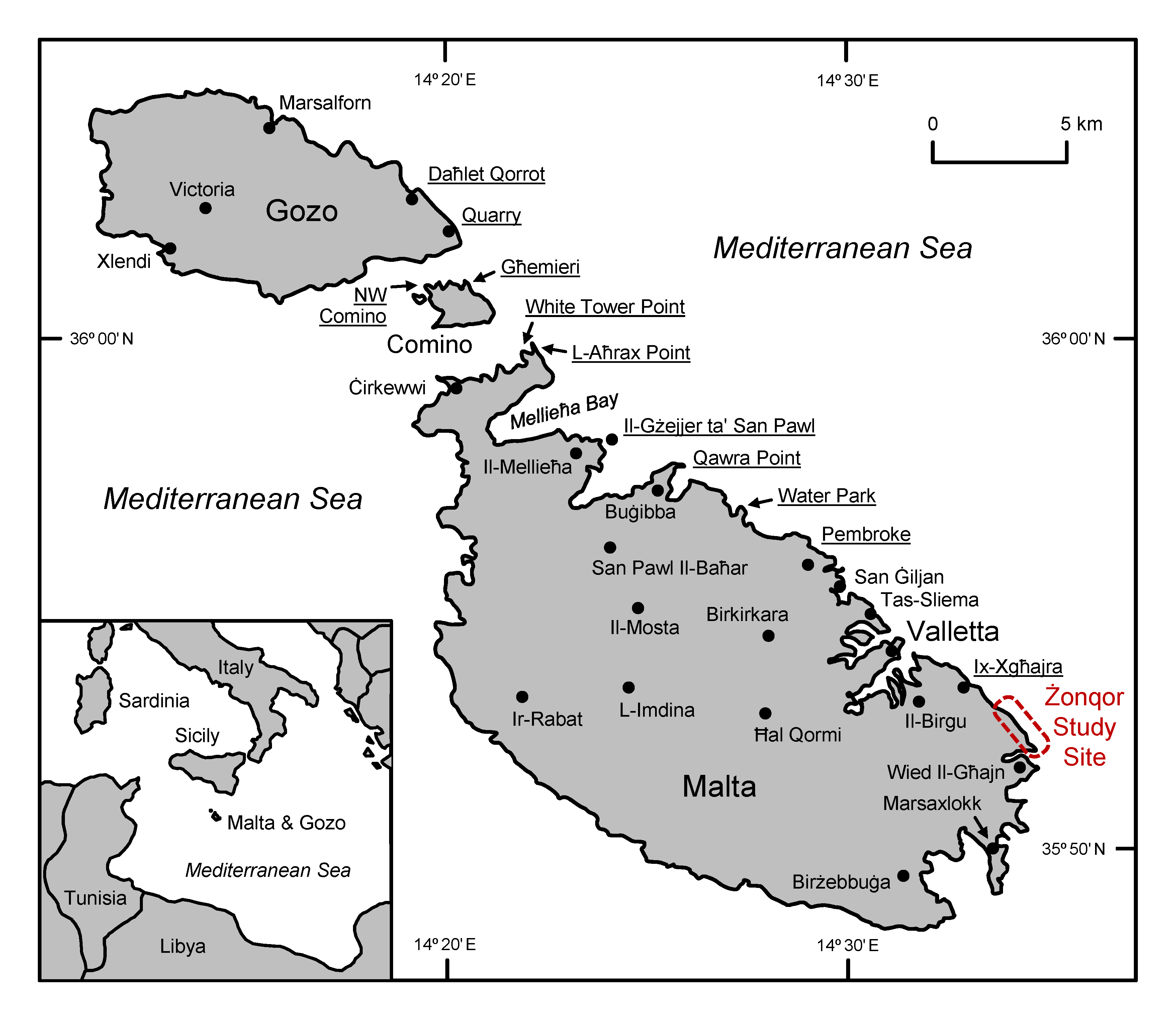
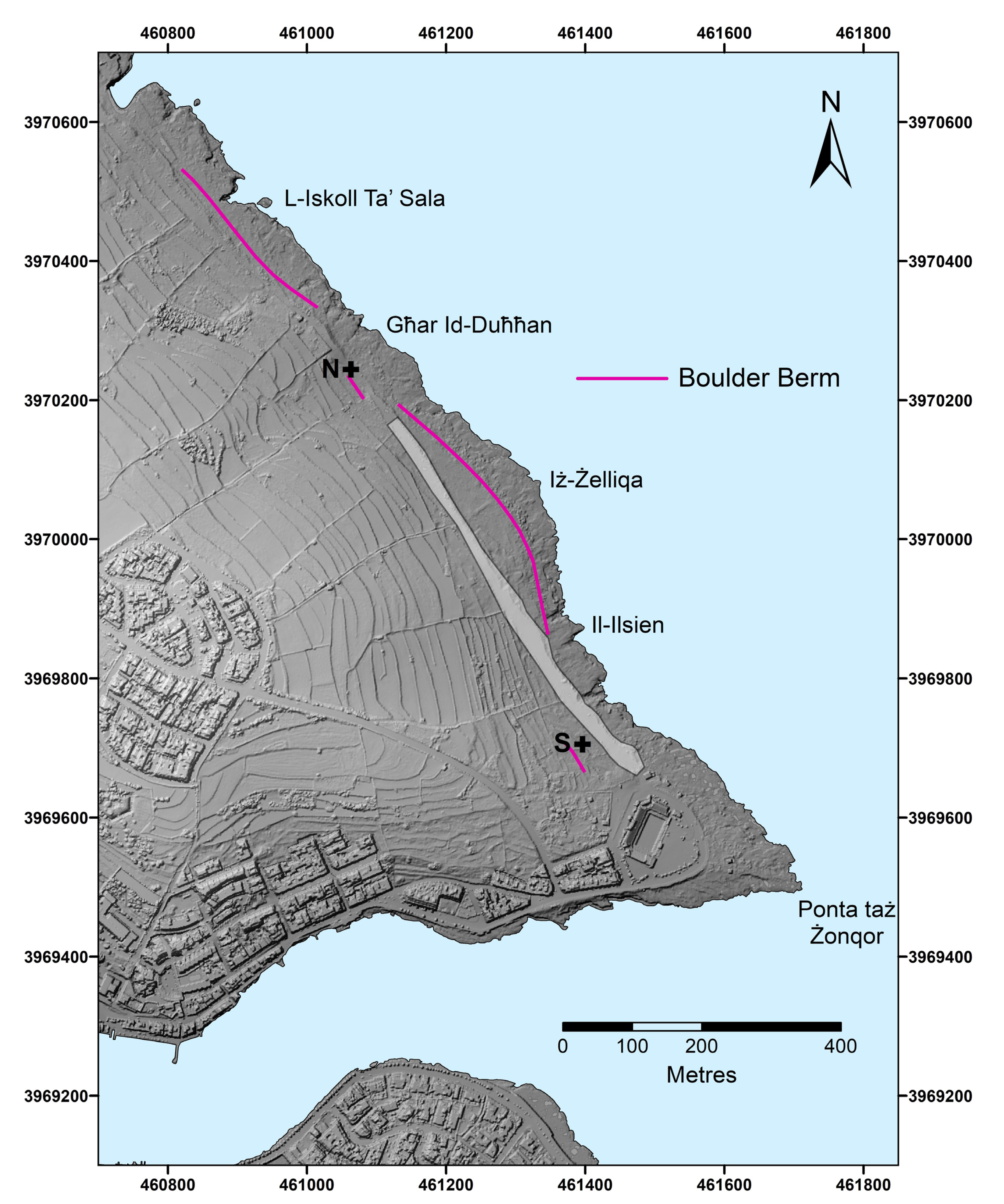
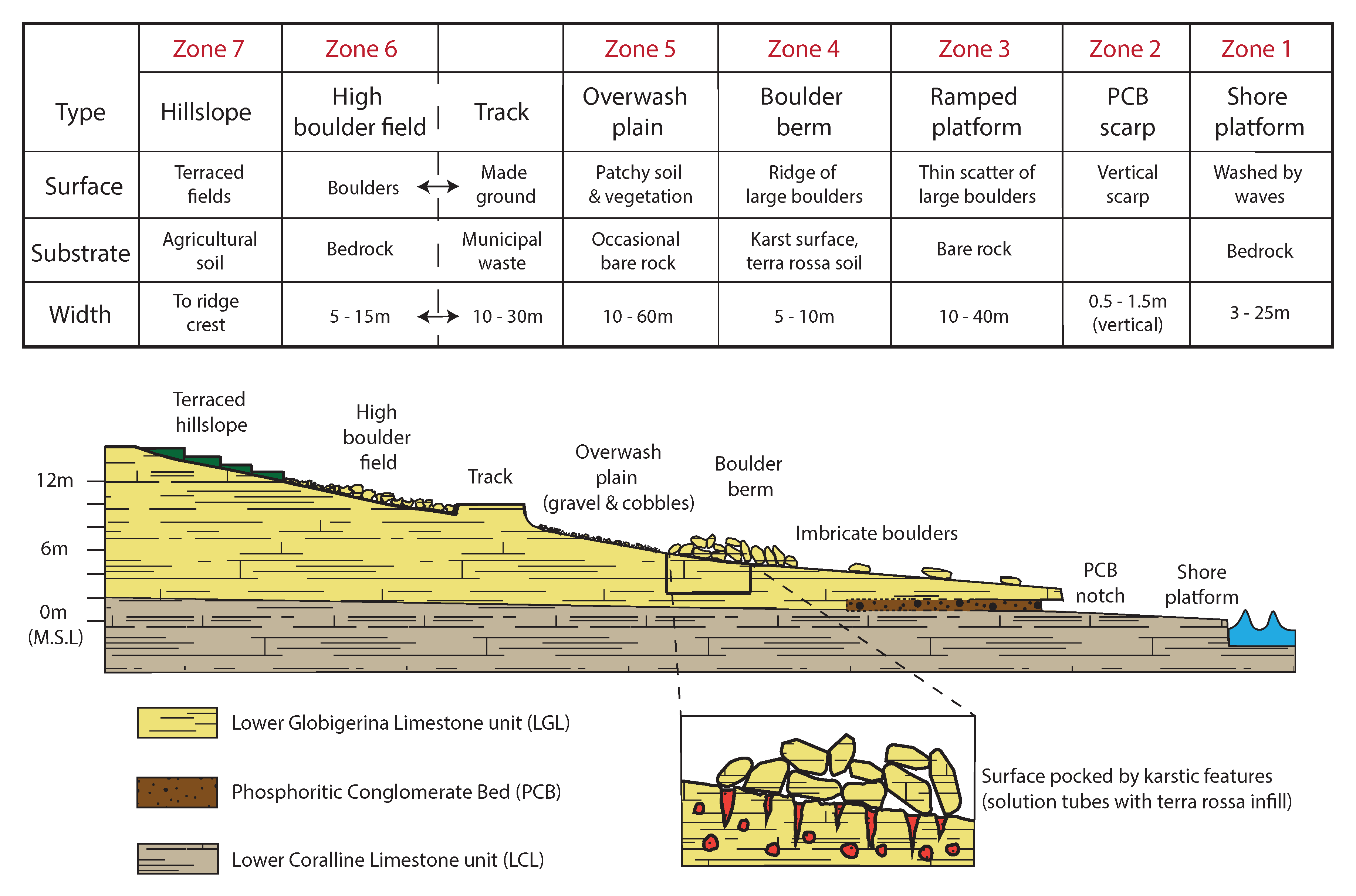
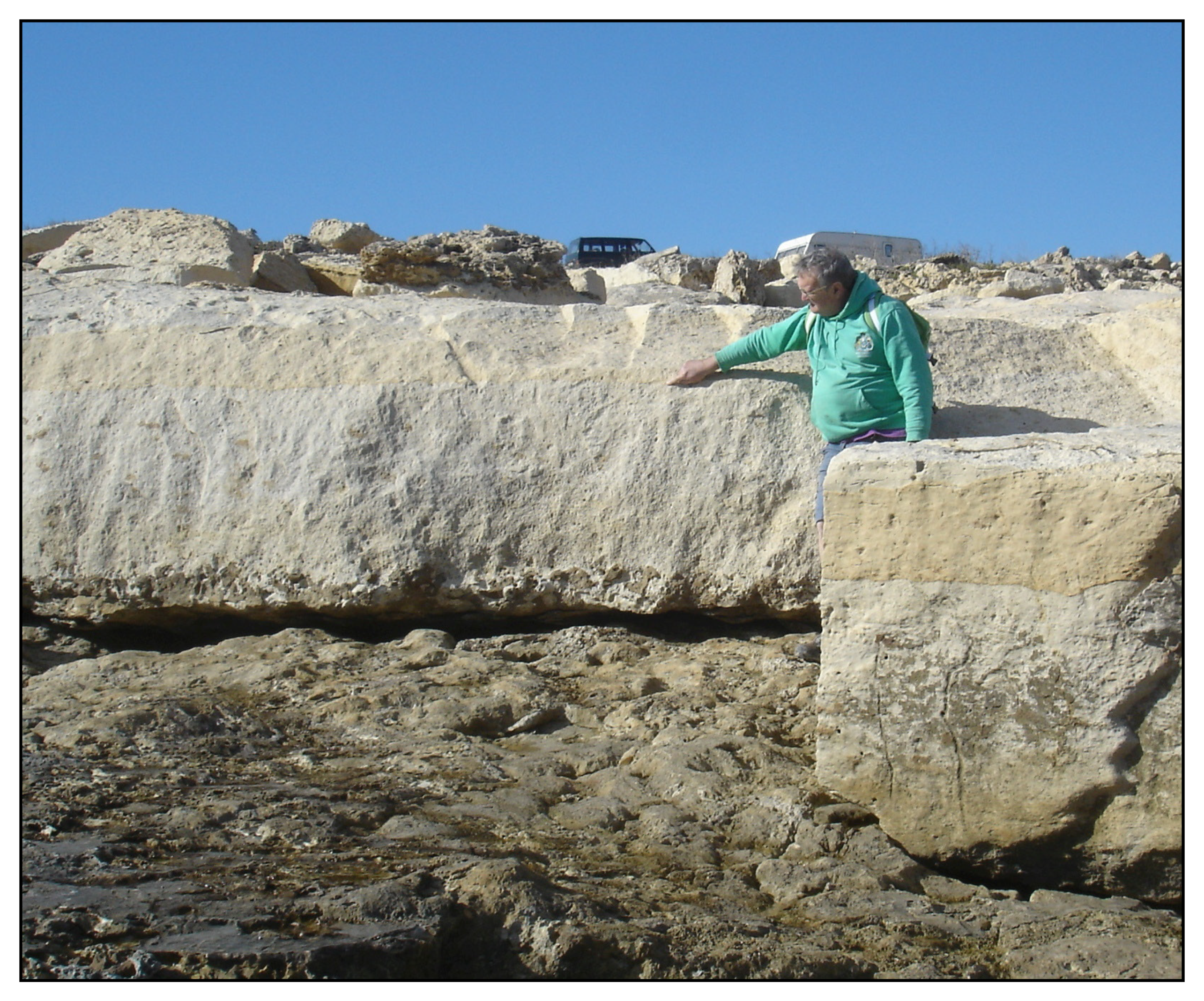

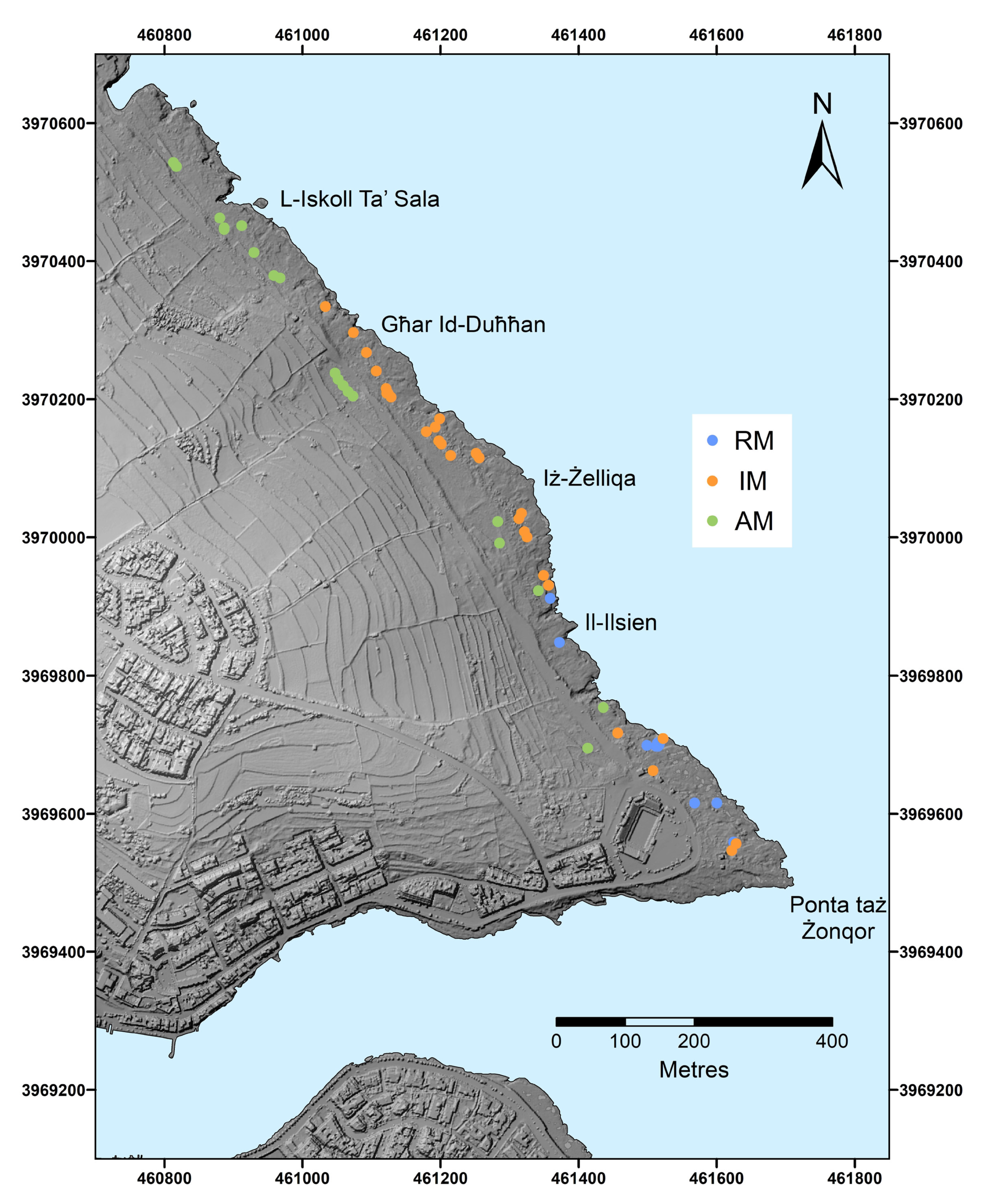
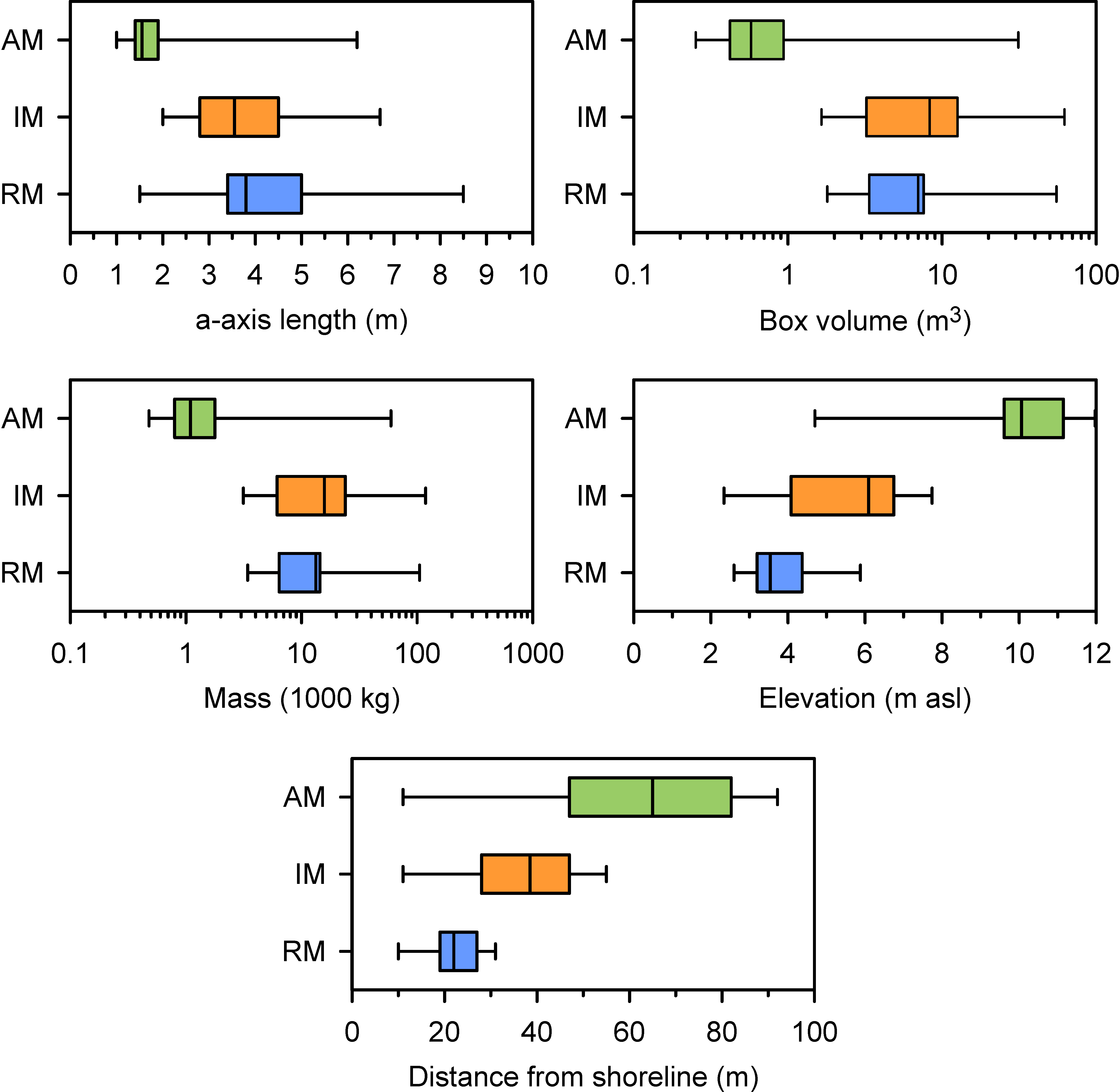
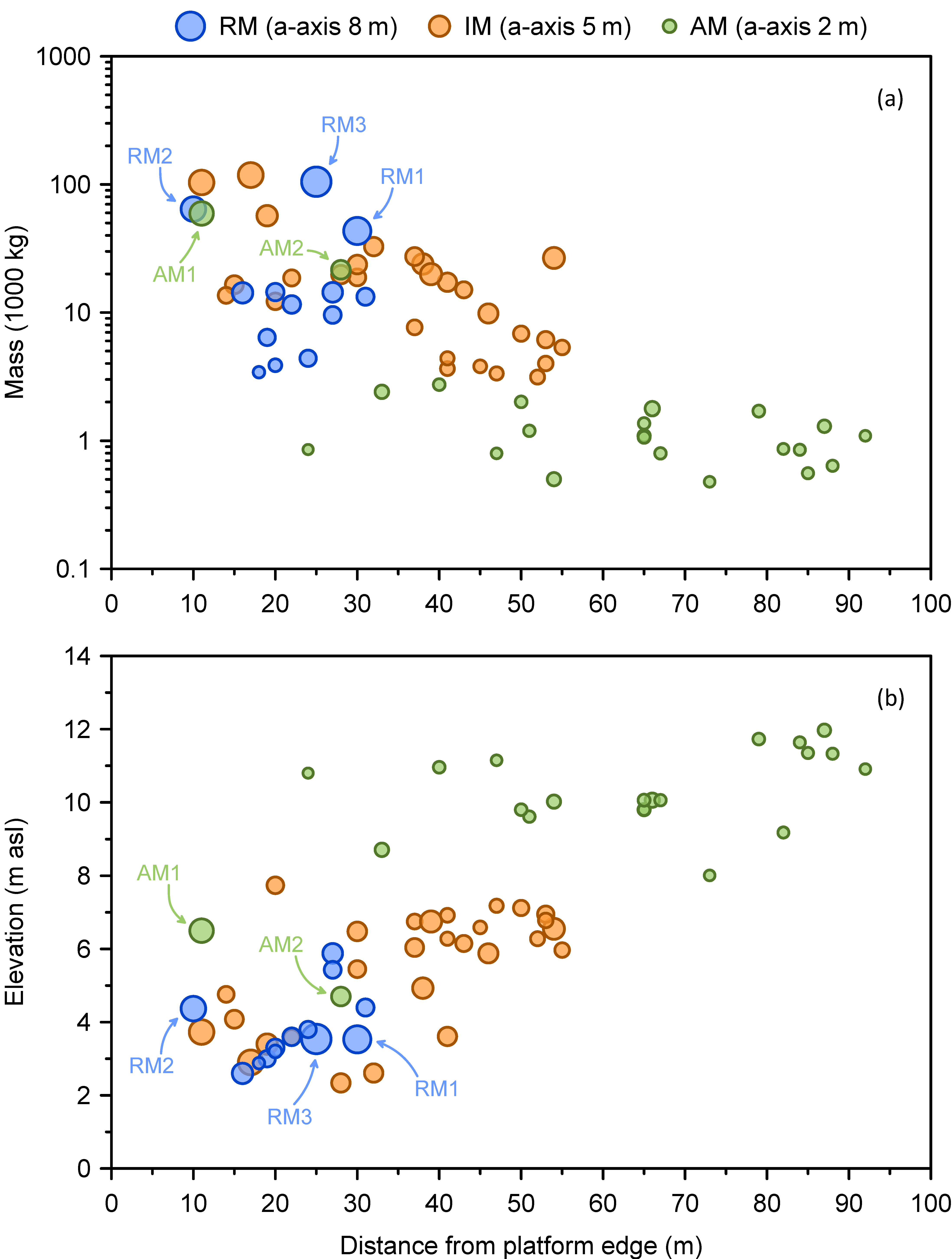
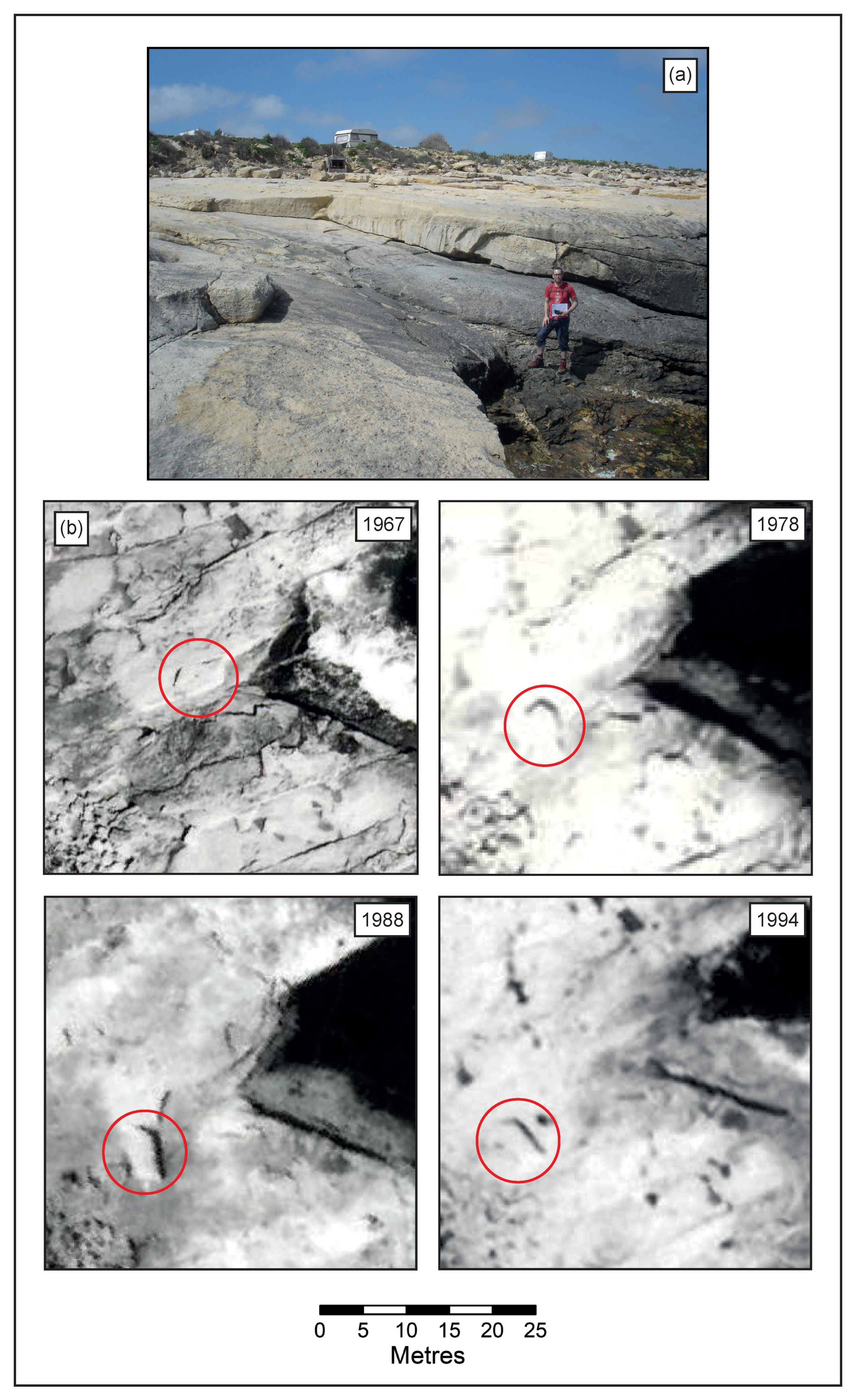
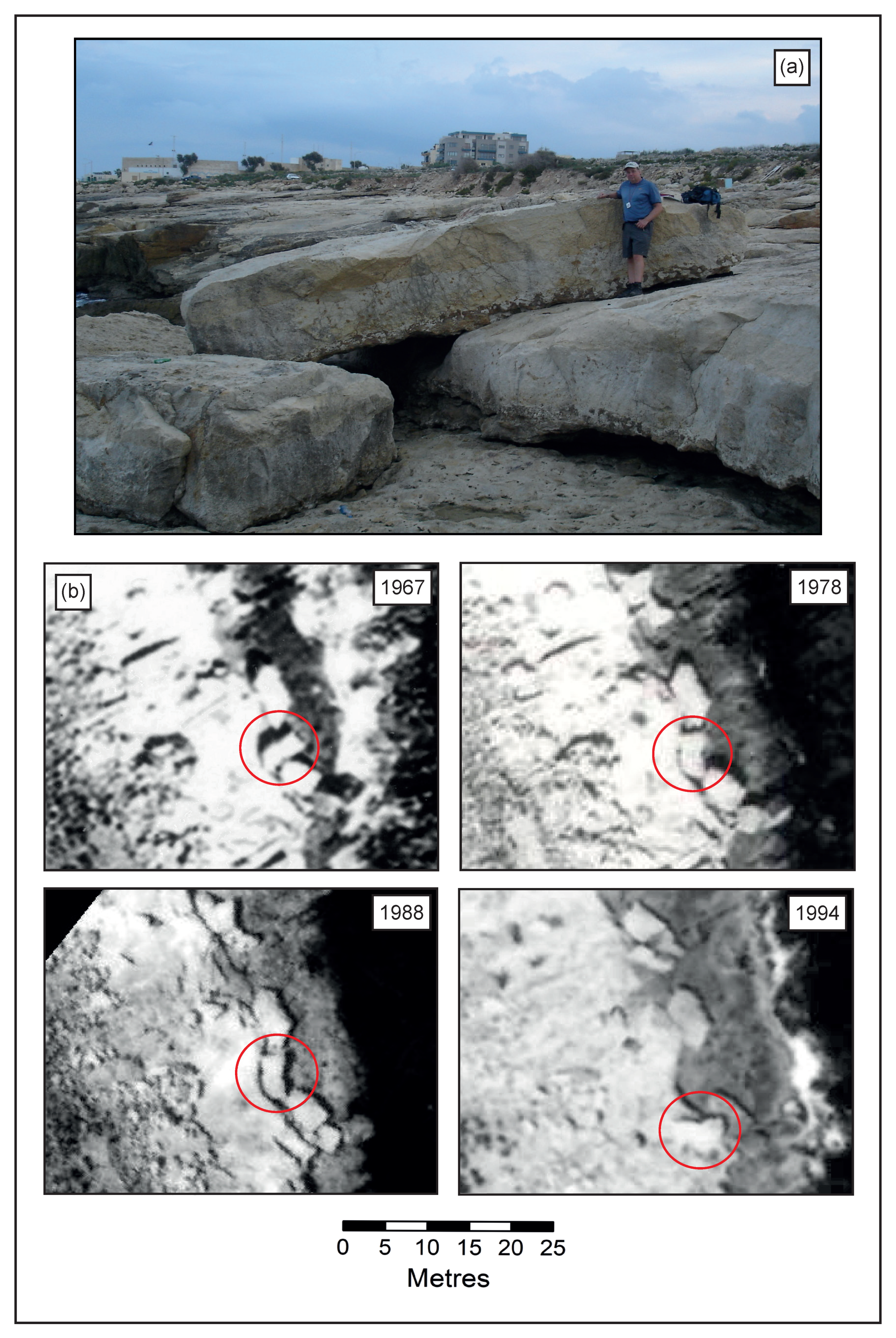
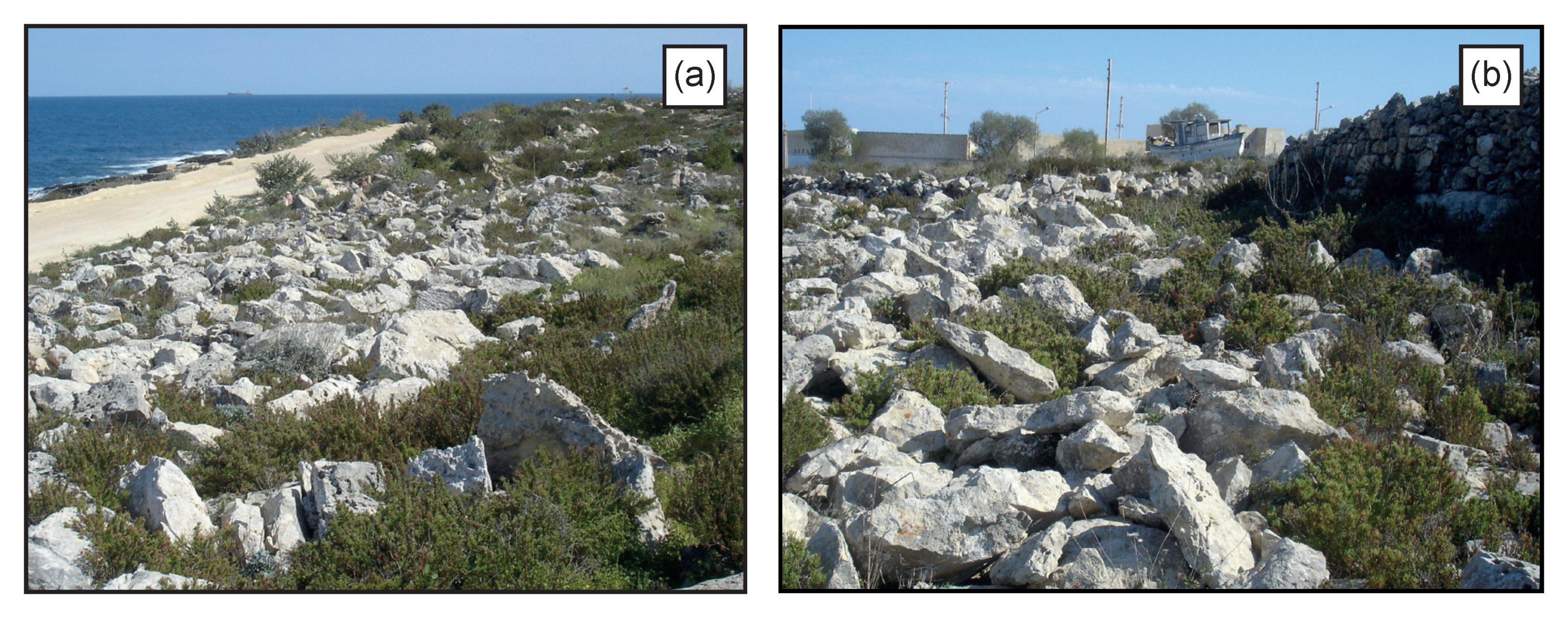
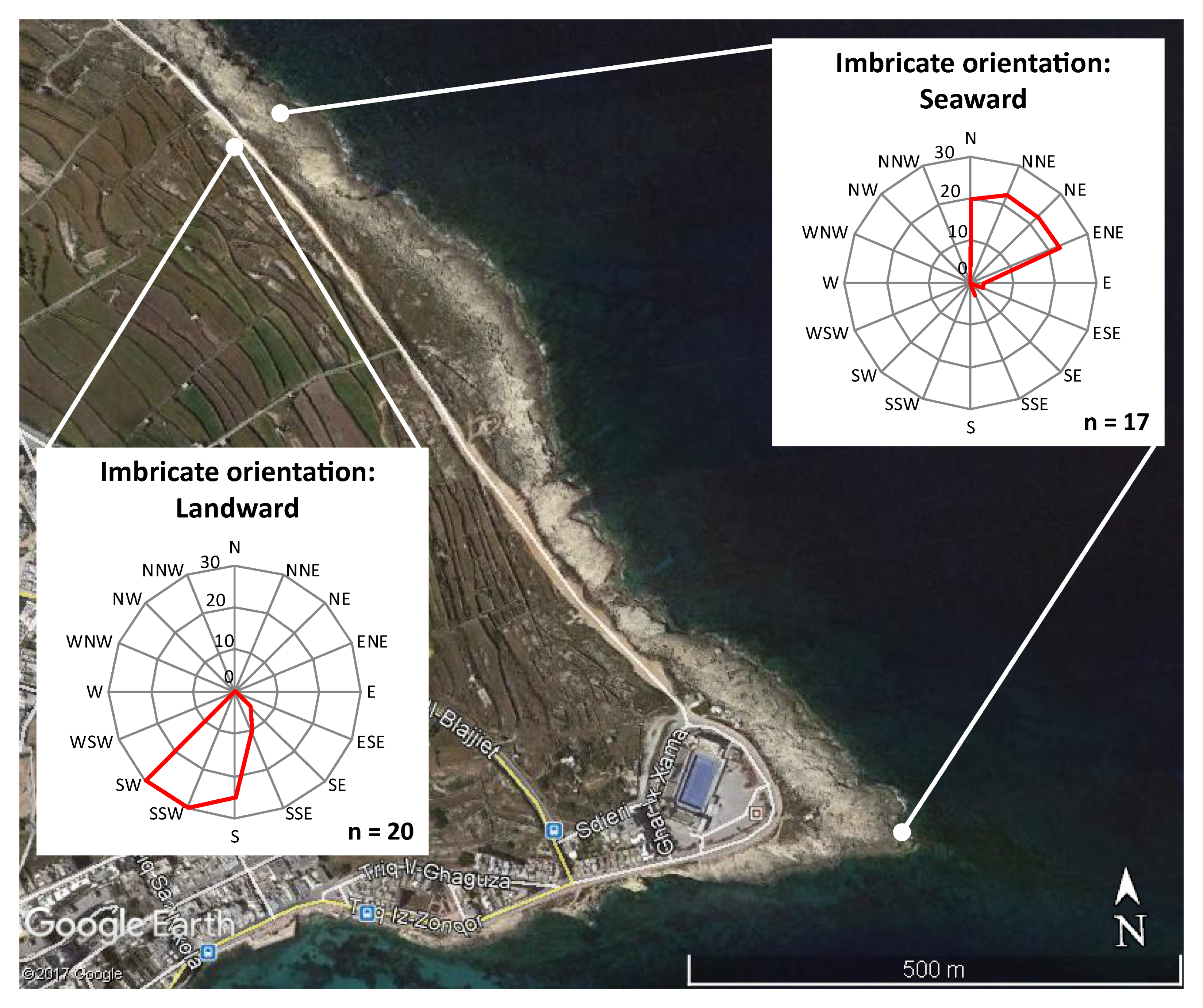
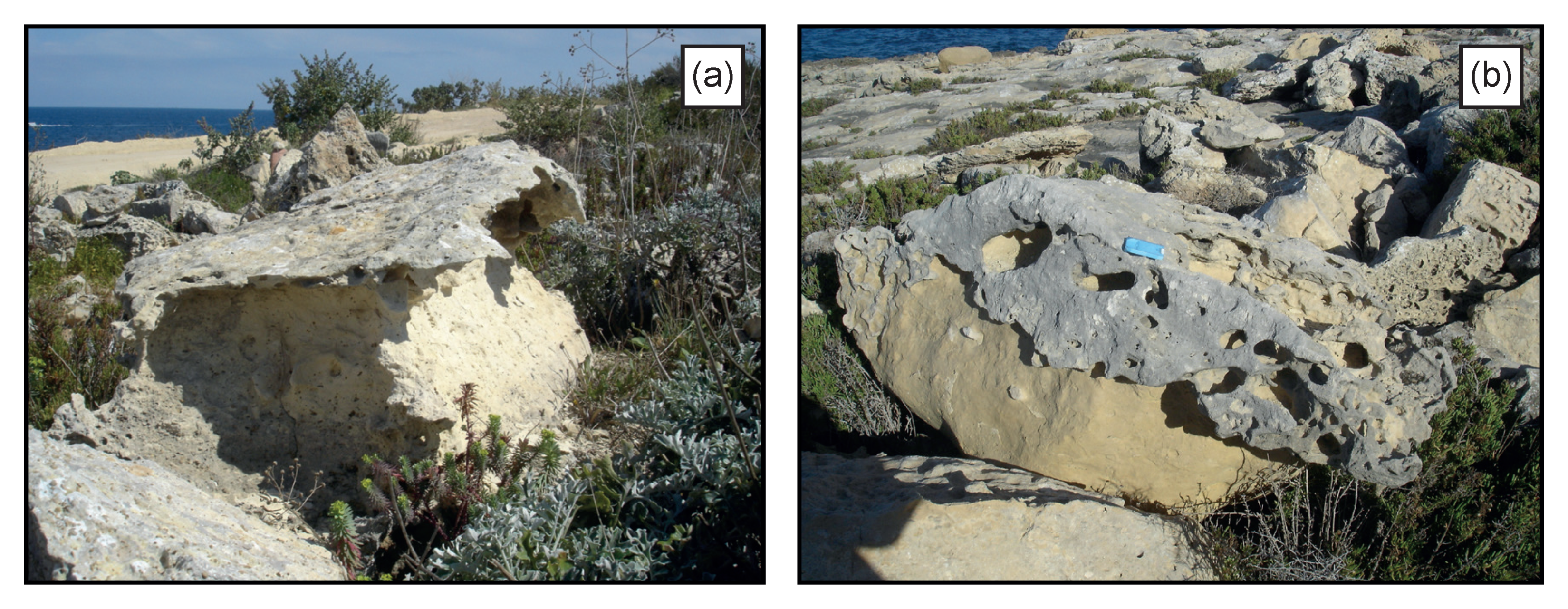
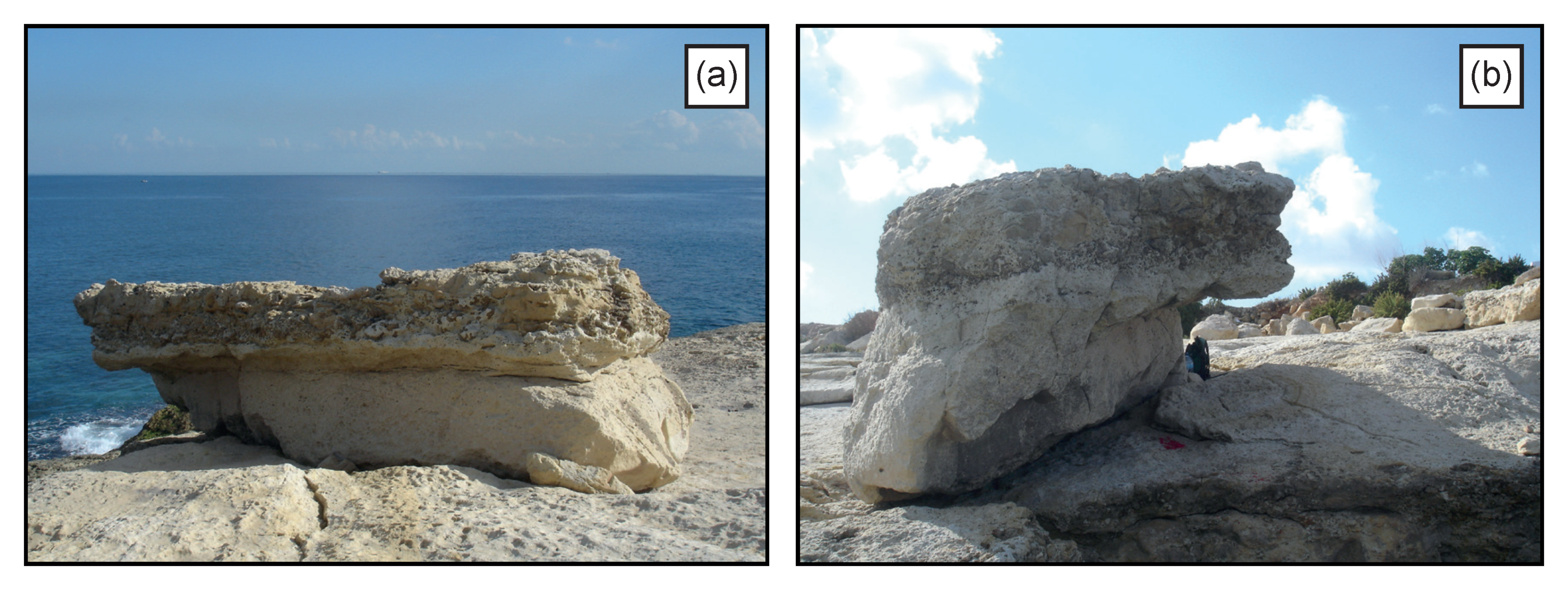
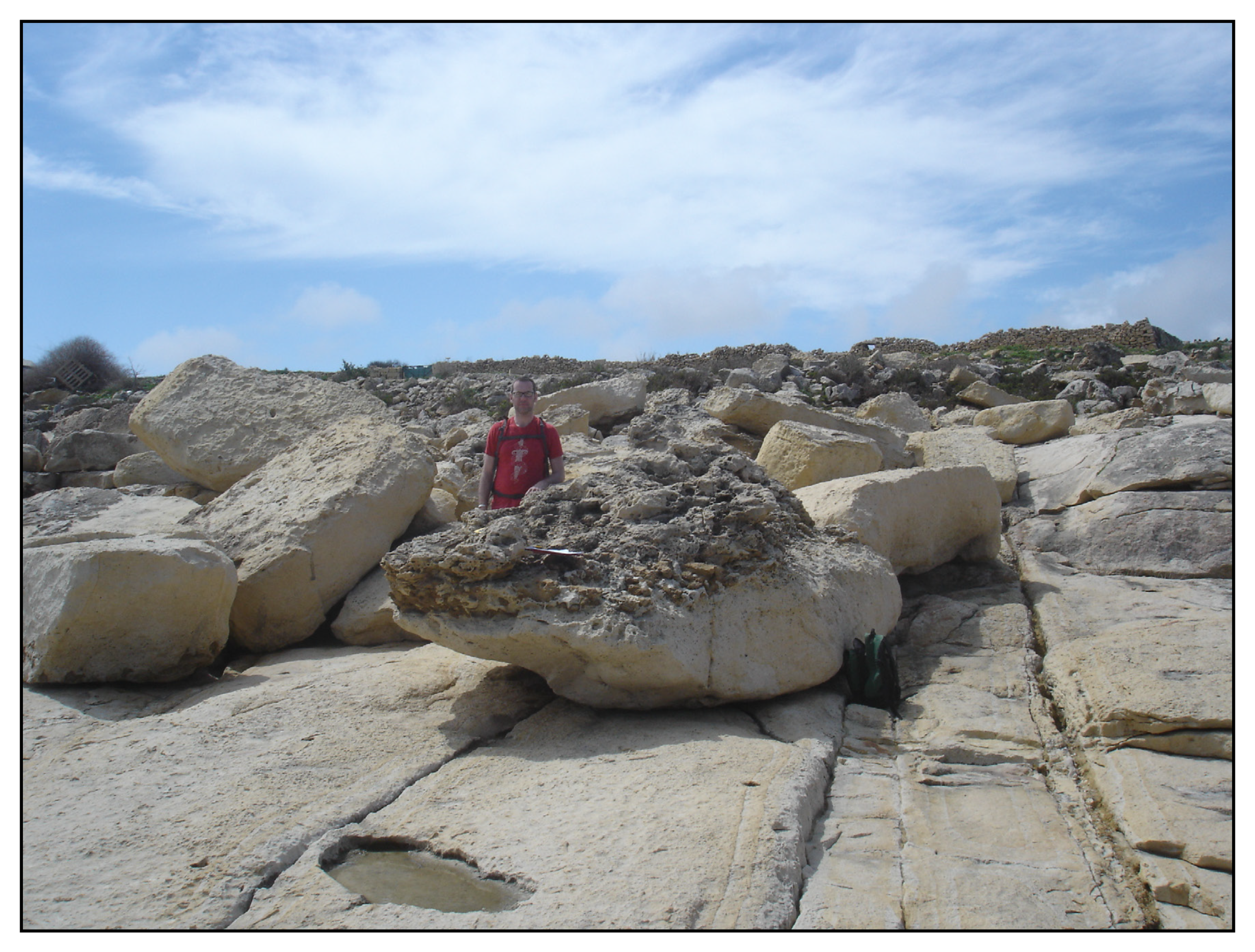
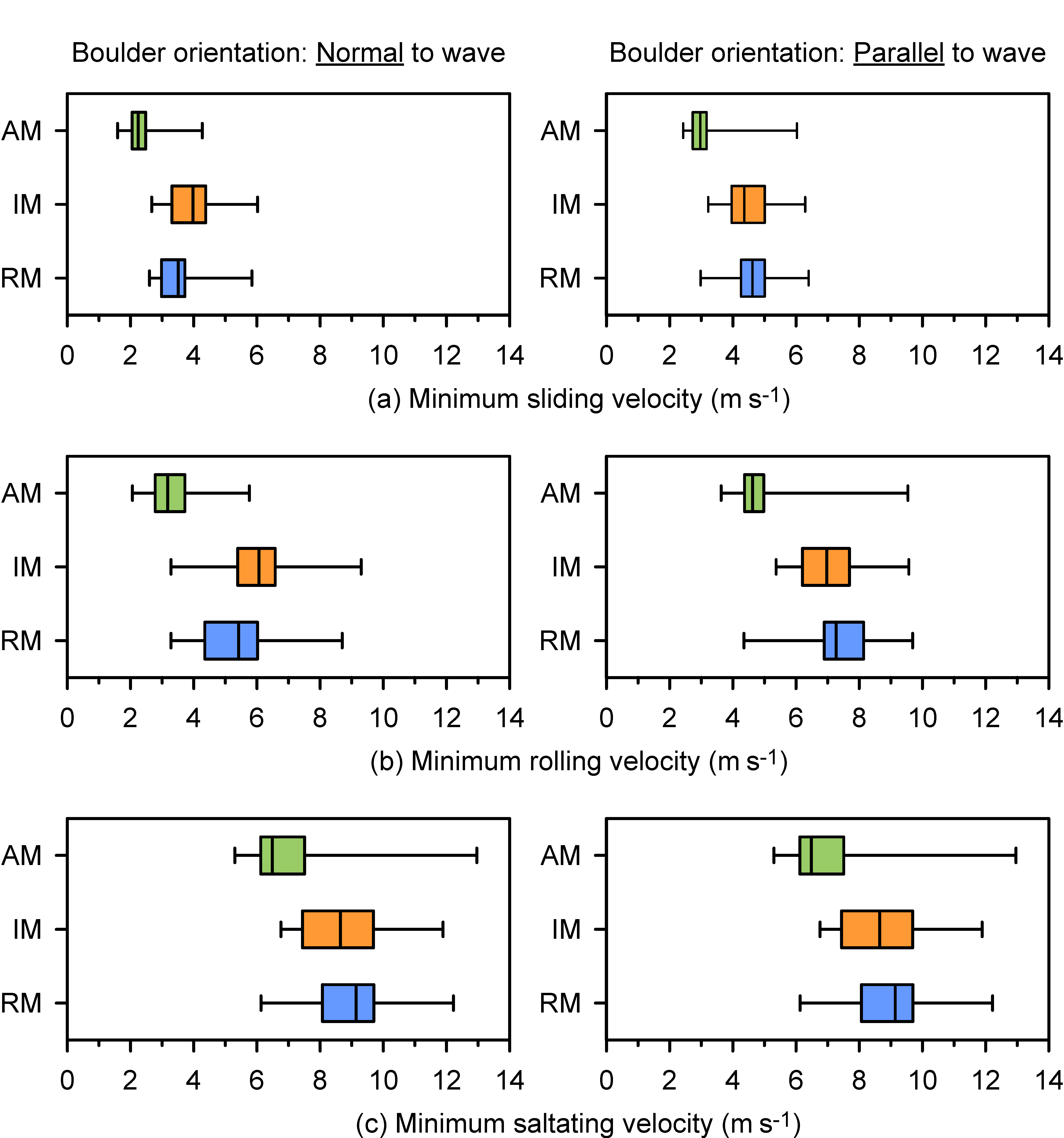
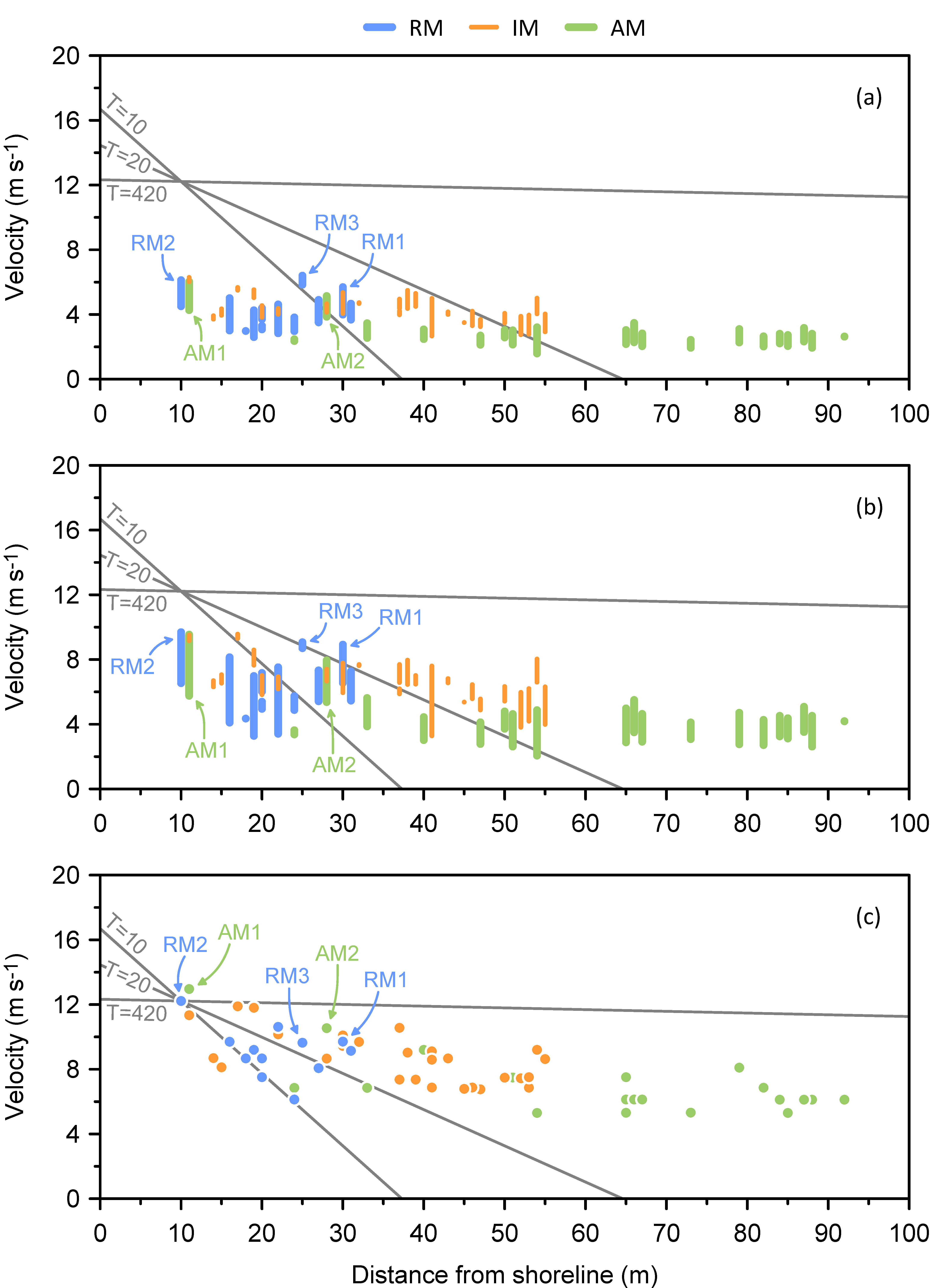
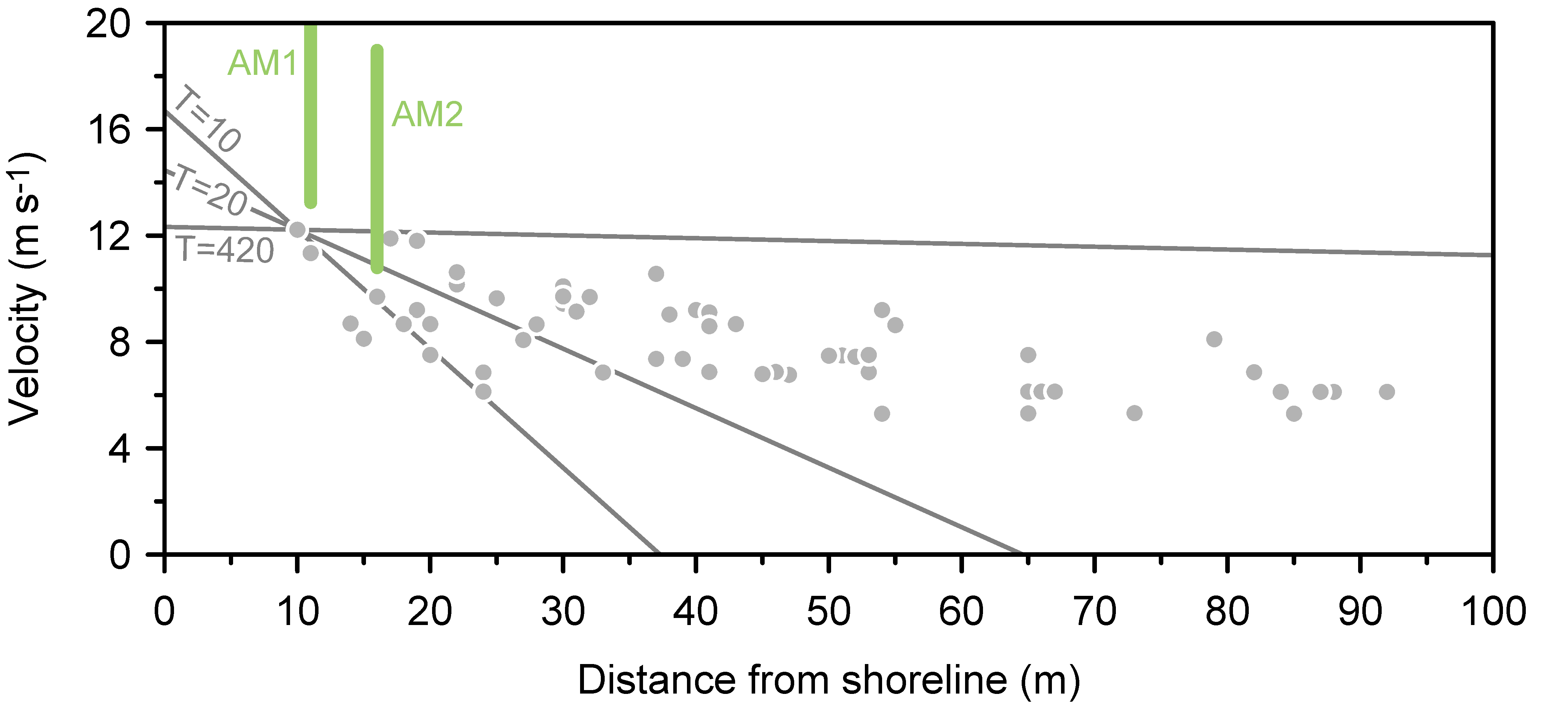
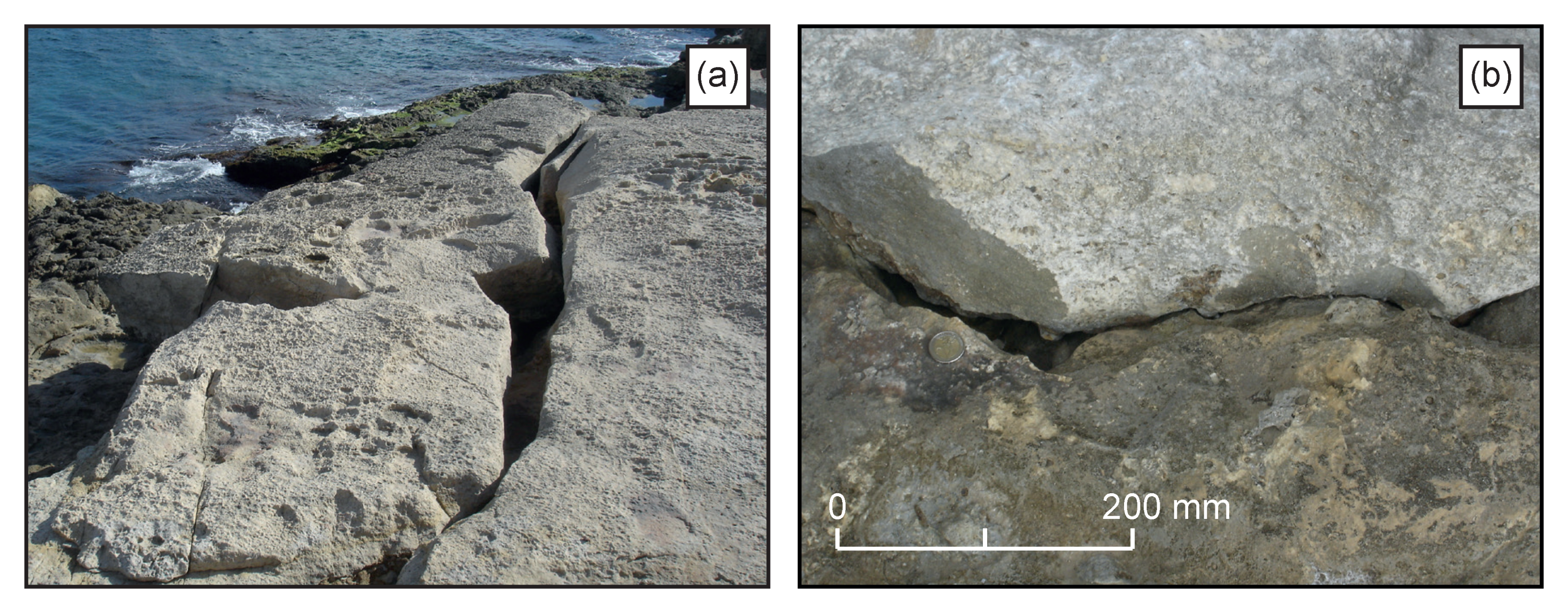
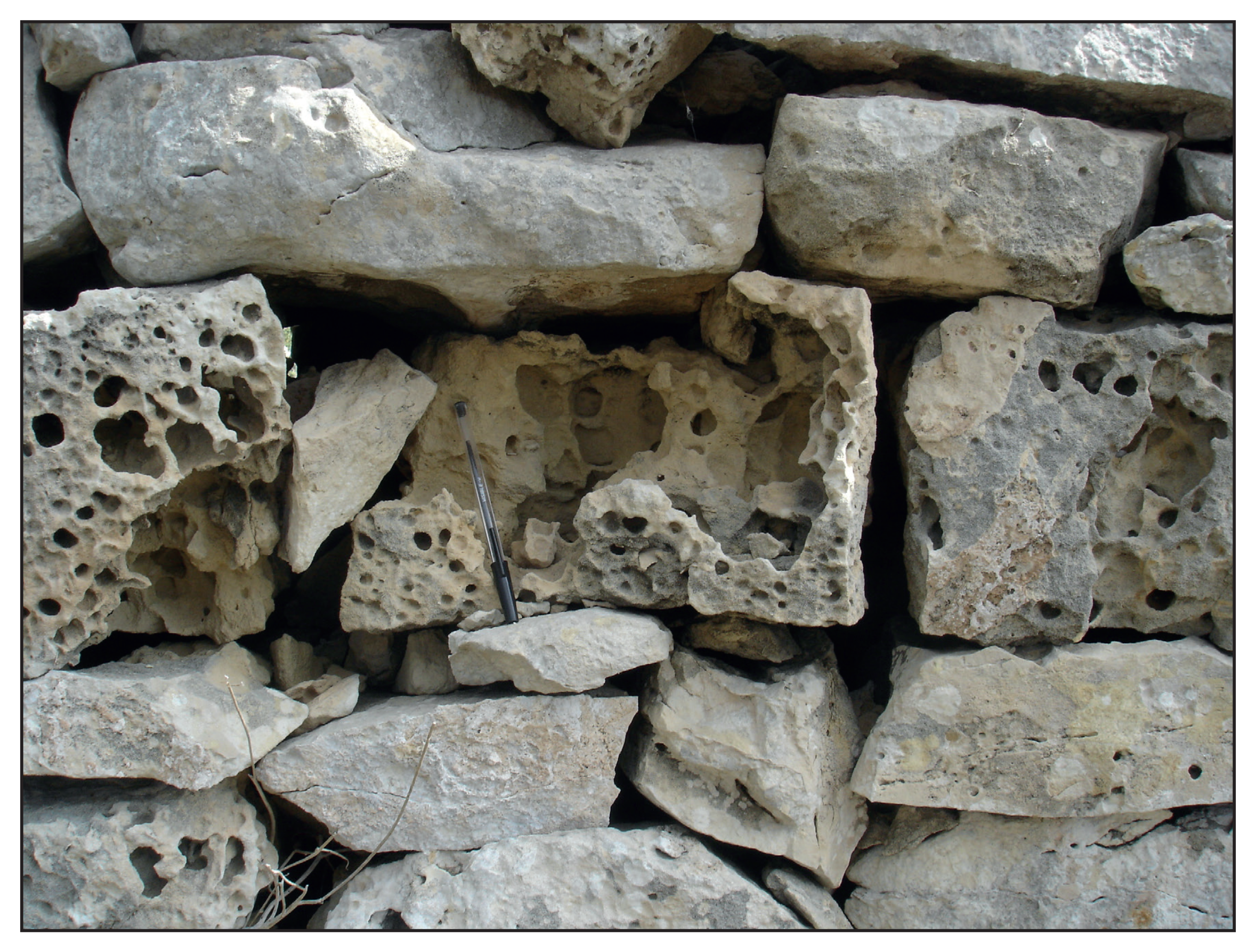
| Factor | Parameters | Derivation |
|---|---|---|
| Location | Distance from shoreline | Field measurement, Google Earth |
| Elevation | Elevation above shoreline | Field survey, LiDAR contours |
| Magnitude | Principal axes | Field measurement |
| Volume | Field axial measurement | |
| Mass | Field axial measurements, density observation in laboratory, supported by literature | |
| Attitude | Normal/transverse to shoreline, inverted, stacked, imbricate | Direct field observation |
| Age in situ | Weathering state | Direct field observation |
| Hydrodynamic implications | Flow velocity and wave height at deposition | Estimated via boulder transport modelling |
| Image Date | Type 2 | Recent Mover Boulder (RM) ID 1 | Moves per Interval 3 | ||||||||||
|---|---|---|---|---|---|---|---|---|---|---|---|---|---|
| RM 1 | RM 2 | RM 3 | RM 4 | RM 6 | RM 7 | RM 8 | RM 9 | RM 11 | RM 12 | RM 13 | |||
| 17/08/1957 | AP | ⊗ | ◯ | ⊗ | ⊗ | ⊗ | ⊗ | ⊗ | ⊗ | ⊗ | ⊗ | ⊗ | - |
| 10/11/1967 | AP | ❶ | ◯ | ⊗ | ❶ | ⊗ | ❶ | ⊗ | ⊗ | ⊗ | ⊗ | ⊗ | 3 |
| 10/12/1978 | AP | ❷ | ❶ | ⊗ | ❷ | ⊗ | ◯ | ⊗ | ⊗ | ⊗ | ⊗ | ⊗ | 3 |
| 31/08/1988 | AP | ❸ | ◯ | ❶ | ◯ | ❶ | ◯ | ❶ | ❶ | ❶ | ❶ | ❶ | 8 |
| 04/05/1994 | AP | ◯ | ❷ | ◯ | ❸ | ❷ | ❷ | ◯ | ◯ | ◯ | ◯ | ◯ | 4 |
| 18/02/2002 | GE | ◯ | ◯ | ◯ | ◯ | ◯ | ◯ | ◯ | ◯ | ◯ | ◯ | ◯ | 0 |
| 15/04/2013 | GE | ◯ | ◯ | ◯ | ◯ | ◯ | ◯ | ◯ | ◯ | ◯ | ◯ | ◯ | 0 |
| Total moves: | 3 | 2 | 1 | 3 | 2 | 2 | 1 | 1 | 1 | 1 | 1 | 18 | |
© 2020 by the authors. Licensee MDPI, Basel, Switzerland. This article is an open access article distributed under the terms and conditions of the Creative Commons Attribution (CC BY) license (http://creativecommons.org/licenses/by/4.0/).
Share and Cite
Mottershead, D.N.; Soar, P.J.; Bray, M.J.; Hastewell, L.J. Reconstructing Boulder Deposition Histories: Extreme Wave Signatures on a Complex Rocky Shoreline of Malta. Geosciences 2020, 10, 400. https://doi.org/10.3390/geosciences10100400
Mottershead DN, Soar PJ, Bray MJ, Hastewell LJ. Reconstructing Boulder Deposition Histories: Extreme Wave Signatures on a Complex Rocky Shoreline of Malta. Geosciences. 2020; 10(10):400. https://doi.org/10.3390/geosciences10100400
Chicago/Turabian StyleMottershead, Derek. N., Philip J. Soar, Malcolm J. Bray, and Linley J. Hastewell. 2020. "Reconstructing Boulder Deposition Histories: Extreme Wave Signatures on a Complex Rocky Shoreline of Malta" Geosciences 10, no. 10: 400. https://doi.org/10.3390/geosciences10100400




